
Miscellany (pdf)
|
Environmentally friendly mariculture - challenges of marine fish culture in Mainland China |
|
| Birdbrains in Big Bird Race 2006 | |
|
Kadoorie Farm & Botanic Garden - wildlife updates & sightings |
Environmentally friendly mariculture - challenges of marine fish culture in Mainland China (pdf)
by Liu Min
Mariculture production in Mainland China, inclusive of fishes, crustaceans, molluscs and seaweeds, has rapidly increased over the last two decades (Fig. 1). To date, more than 50 marine fish species from over 20 families are cultured, mainly in earthen ponds (Fig. 2) and inshore (shallow coastal water) floating cages (Hong & Zhang, 2003) (Figs. 3 & 4); offshore (deep water) submersible cages have recently been developed (Chen Jiaxin, unpublished data) (Fig. 5).
Here I do not intend to look into this industry in great detail. Instead, I discuss several of the problems that the marine fish culture industry in Mainland China faces. From both biological and ecological perspectives, these problems cannot be ignored, and greater focus is needed on a more environmentally friendly approach to mariculture. Major issues are the practice of grow-out of wild-caught fish (therefore continued exploitation of wild populations), alien species introductions, loss of genetic diversity and pollution from mariculture operations. Since pollution aspects associated with mariculture are well-known in the region (Yang et al., 2004), I will focus only on the first three issues.
 |
| Fig. 1. Estimated annual marine production (including marine fishery and mariculture) (´ 10,000 t) in Mainland China between 1970 and 2004, showing marine fish culture production by year (percentages are grow out rates) (http://www.lib.noaa.gov/china/aquaculture) (Chen Jiaxin & Wong Jiangyong, unpublished data). |
 |
| Fig. 2. Earthen ponds for grouper and snapper culture in Lingshui (Hainan Province). The investment is relatively low. Fish culture is divided into certain stages, e.g. juvenile culture (from new-hatched larvae to about 5-10 cm TL), grow-out culture (from about 5-10 to 20 cm TL, <500 g), and market size culture (from <500 g to market size). Farmers only focus on one of these stages. |
 |
| Fig. 3. Crowded inshore floating cages mainly for large yellow croaker (Larimichthys =[Pseudosciaena] crocea) culture in Ningde (Fujian Province). The culture production of this species from the Province contributed to more than 80% of the total national culture production of the species. In 2004, there were more than one million floating cages in Mainland China, with more than 50% in Fujian Province (Chen Jiaxin, unpublished data). (Photo: Prof. Chen Jiaxin). |
Of more than 50 marine fish species cultured in Mainland China, only about 10 have achieved hatchery-based mariculture (i.e. both broodstock and cultured fish are from captive breeding) (Hong & Zhang, 2003); for the majority, wild-caught juveniles are the main source of grow-out culturing. The activity of ‘growing-out’ wild-caught fish in captivity is not relevant for addressing overfishing because it does not necessarily reduce fishing pressure on wild stocks of these species (Sadovy, 2001). For instance, for the Hong Kong grouper (Epinephelus akaara) (Fig. 6), listed as ‘endangered’ on the IUCN Red List in 2003 and the most expensive grouper in Hong Kong’s live food fish market today, captive breeding has never been successful on a large scale since first attempted in the 1960s. The mariculture production of this species is still mainly from ‘growing-out’ wild-caught juveniles (Wang Hansheng, personal communication). Shortage of governmental financial support for biological and ecological studies, and with lack of management, its fishing condition and biological status have little chance to improve. Information on its spawning behaviour in the wild, spatial and temporal movement patterns and habitat use throughout its life cycle, population size, landing volumes and catch per unit effort are needed for carrying out management initiatives. Such information, in turn, can also provide guidelines to improve captive breeding techniques (Liu & Sadovy, 2006).
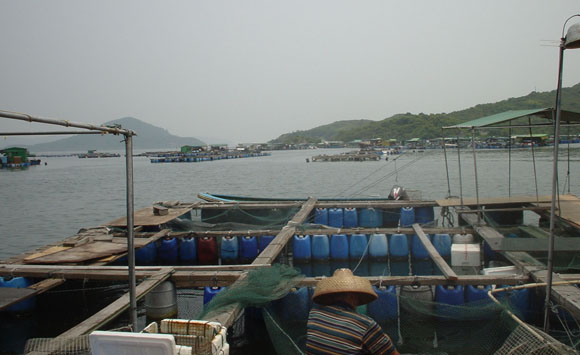 |
| Fig. 4. Inshore floating cages for multiple fish species cultured in a Hong Kong mariculture zone. The marine fish culture industry in Hong Kong faces similar problems to Mainland China and elsewhere, such as water pollution and diseases. Meanwhile, high operation investment in Hong Kong makes cultured fish prices higher than those in Mainland China, and less competitive (Chan 2005). |
 |
| Fig. 5. Offshore submergible cages for cobia (Rachycentron canadum) and Greater amberjack (Seriola dumerili) culture in Nanao (Guangdong Province). These cages can be submerged when typhoons or red tides come. |
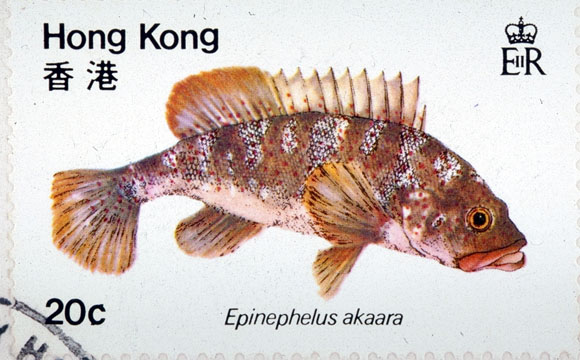 |
| Fig. 6. The Hong Kong grouper (Epinephelus akaara) |
Second, there is no sufficient and effective management of alien fish species introductions in Mainland China, in general. Shandong Province, as one example, has introduced about 30 fish species (both marine and freshwater) for mariculture purposes over the last decade (Liu et al., 2003). However, most of the species fail to establish themselves in culture operations in the region, mainly because of insufficient evaluation of the species before introductions, and because there is no effective management to maintain good economic characteristics following introduction. For instance, the turbot [Psetta maxima (= Scophthalmus maximus)] has to be repeatedly introduced from Europe due to the rapid loss of its ‘good’ characteristics (e.g. flesh quality, high growth rate) after one or two generations of captive breeding, which result in ‘bad’ characteristics (e.g. early maturation and albinism) (Liu et al., 2003). For relatively successful species, current management is also not enough. For instance, the red drum (Sciaenops ocellatus), introduced from the United State in the mid-1990s, has had more than 10 million juveniles produced annually (Hong & Zhang, 2003), and the estimated mariculture production was about 43,500 tonnes (about 7.5% of the total marine fish culture production) in 2003 (Zhou & Wang, 2004). Considering its adaptability, the possibility of the species establishing itself in the wild with unknown consequences cannot be ignored (Sadovy, 2000) (Fig. 7). In another case, an introduced fish species, the redtail catfish (Phractocephalus hemiolioterus), was caught from the Pearl River Estuary (Fig. 8). Using closed systems and sterile individuals for culturing introduced fish species should be considered.
 |
| Fig. 7. An individual of the red drum (Sciaenops ocellatus) was caught in the bay of the Swire Institute of Marine Science (SWIMS) on 20/06/06. The culture scale of this exotic species in southern Mainland China is large; the individual could have escaped from fishing vessels during transport or from floating cages or even intentional releases. |
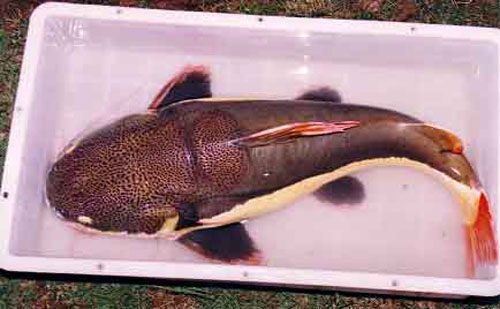 |
| Fig. 8. The redtail catfish (Phractocephalus hemiolioterus), a freshwater fish that naturally occurs only in South America. This species was introduced into Mainland China in the late-1990s for public aquarium exhibition. An individual was caught from the Pearl River Estuary in 2001. |
Third, apparent losses of characteristics considered to be of economic value (e.g. flesh quality, high growth rate and disease assistance) and genetic diversity in maricultured fish species, are not uncommon. For instance, cultured individuals of the large yellow croaker Larimichthyes (= Pseudosciaena) crocea, after several generations in captivity, mature at younger age and smaller size, and have slower growth rates and lower genetic diversity than wild-caught individuals (Liu & Sadovy, unpublished manuscript). It is also noted that the genetic diversity of its wild stocks is particularly low. There are at least three possible explanations. First, this species was heavily exploited at its spawning and over-wintering aggregations between the 1950s and 1970s with almost no fishery management. Its fishery collapsed in the 1980s. Since then its spawning aggregations have never reappeared. Second, captive breeding started, following over-exploitation, by using only small number of broodstock from the wild and then a small number of broodstock was taken from captive-bred individuals. This may reduce the genetic diversity of the species after several generations in captivity. Third, large-scale and long-term restocking programmes in the last decade in the East China Sea, the major source area for this species, by restocking captive-bred juveniles with low genetic diversity, may further contaminate the gene pools of its wild stocks. The case of the large yellow croaker sends a clear message of the importance of maintaining genetic variation, conserving biodiversity, and of timely, sufficient and effective management.
To date, offshore submersible cage culture (Fig. 5) is considered to be one of the environmentally friendly mariculture modes in Mainland China, and has been promoted by fishery departments through financial support to investment companies. The economic benefits reported relate to high survival and grow rates, and, presumably, reduced pollution risks for inshore waters. Because of the high cash input necessary for the submersible cage culture industry, most traditional, inshore, small-scale, floating cage culture farmers cannot become involved (Fig. 9). Therefore, inshore cage culture operations, have little prospect of becoming reduced or abandoned, at least in short term, and the associated environmental problems in inshore waters will not be improved or become solved (Fig. 10). Developing offshore cage culture should be planned together with reducing inshore culture scales to achieve the ideal plan for environmentally friendly mariculture.
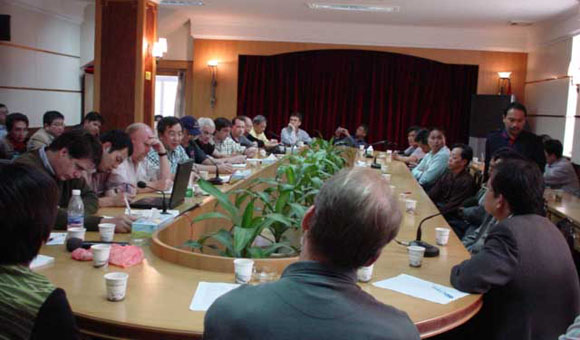 |
| Fig. 9. Meeting with farmers in Nanao (Guangdong Province), to discuss the future of mariculture development. |
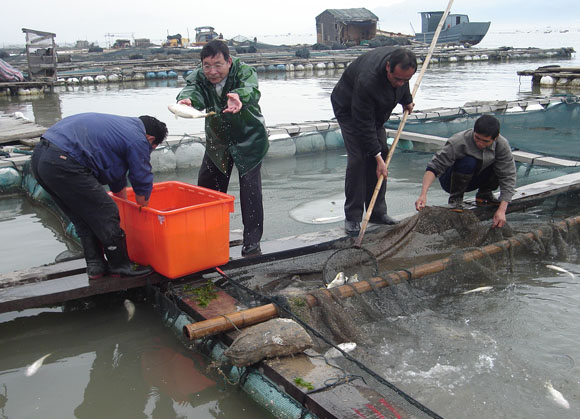 |
| Fig. 10. High fish mortality in inshore floating cages when disease breaks out. (Photo: Prof. Chen Jiaxin). |
Bibliography
Chan, T.T.C. (2005). Study on the current status and potential sustainable development of the aquaculture industry in Hong Kong (http://www.civic-exchange.org).
Hong, W.S. & Zhang, Q.Y. (2003). Review of captive bred species and fry production of marine fish in China. Aquaculture 227: 305-318.
Liu, M. & Sadovy, Y. (2006). Call for action on the Hong Kong grouper Epinephelus akaara. Page P-44 in Programme, Abstracts and Directories, First Asia-Pacific Coral Reef Symposium (APCRS), 18-24/06/06. The Chinese University of Hong Kong.
Liu, M. & Sadovy, Y. (unplub. ms.). ’Cod’ of the East: the life, times and demise of the large yellow croaker (Larimichthys crocea, Sciaenidae).
Liu, S.L., Wang, F.Q., Yang, M., Wang, J.Y., Yang, J.J. & Huang, Z.L. (2003). Investigation and study on the alien species in aquaculture in Shandong Province. Marine Fisheries Research 24(3): 66-71.
Sadovy, Y. (2000). Legal aliens. Porcupine 21: 15-16.
Sadovy, Y. (2001). Summary of regional survey of fry/fingerling supply for grouper mariculture in Southeast Asia. SPC Live Reef Fish Information Bulletin 8: 22-29.
Yang, Y.F., Li, C.H., Nie, X.P., Tang, D.L. & Chung, I.K. (2004). Development of mariculture and its impacts in Chinese coastal waters. Riviews in Fish Biology and Fisheries 14: 1-10.
Zhou, Z.G. and Wang, Z.N. (2004). Marine finfish aquaculture in China. Asia-Pacific Marine Finfish Aquaculture Network Magazine 2(July-September): 18-20.
Note: On 7-11 March 2006, a workshop on the responsible development of mariculture in the Asia-Pacific region was organized by the Food & Agriculture Organization of the United Unions (FAO) and the Network of Aquaculture Centre in Asia-Pacific (NACA). More information about marine fish culture in the Asia-Pacific region is available from http://www.enaca.org/marinefish.
P.24-27
|
Porcupine! |
 Copyright © 2000 |
